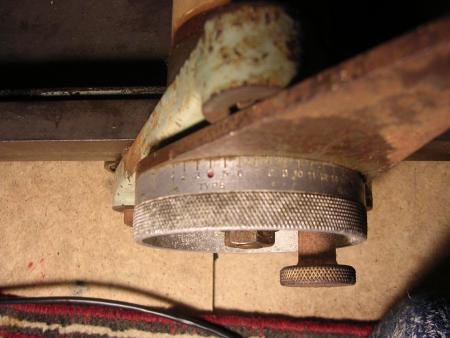Farley galley proofing press
Hello all,
I’ve a question about a Farley proofing press.
The roller has a height-adjustment dial at one end, with markings from 1-19. At mark 4 is a red dot, and TYPE. In place of 15 is another red dot and GALLEY.
1 is the lowest position for the roller, giving the greatest impression, with 19 the least.
The TYPE marking at 4 could refer to the guideline correct adjustment for proofing type set directly onto the bed of the press - except that it doesn’t, because even at 1, the lowest setting, the roller passes over type without touching it.
When using a galley, setting the roller at about 10 gives a good impression, leaving me confused by the mysterious red dots.
Why the variance, I wonder. To allow for different galley thicknesses?
Could anybody with a Farley proofing press shed some light?
Thanks,
Ben.

farley dial.jpg
On my press theres another nut at the bottom of the dial adjuster which can be adjusted to give a datum to ‘type’ for example. Any more pics?
Is the cylinder Rubber or steel?
How old is it?
What kind of packing would you be using (does it require this)?
How about paper thickness?
Perhaps there should be something between the cylinder and the type/paper arrangement (IE tympan wraparound, etc)?
Maybe there are other adjustments elsewhere that have come out of alignment/need to be fixed?
More pictures, please.
Hi
It is possible that your press has been disassembled and reassembled incorrectly causing the dial to misread. All Farleys I have have through my hands print type, plus paper at the “Type” setting. And they print just as well type sitting on a galley which if steel and relatively “modern” ones are about the same thickness. I have had one of these presses apart before and the roller bearings sit in hand finished cross pieces. Whilst cleaning the roller one fell out and it was an awkward job to get it to seat back in. To check the height, I would get a micrometer on it. You will also need to check the relative height between the ball race bearings at the base of the roller mechanism to make sure they are all the right distance too. Take care whilst doing this if you feel confident enough to do it, otherwise you may exacerbate the problem.
Good luck,
Jeremy.
I have a British Printer specification manual of printing machinery and looked it up but it only gives weight, sheet size, etc., however there is also a full page advert which states the farley nos.11 and 12 represent a completely new addition to the range of presses by an ingenius system the cylinder is driven by the steel driving members which are always in contact with the bearers, by rotating the hand wheel proofs can be taken from type in chase or on a galley of any thickness up to 6 points without the need of a loose plate or moving bed. The hand-wheel is calibrated with 19 positive divisions to provide any height between low type high and thick galley and can be locked in any position.